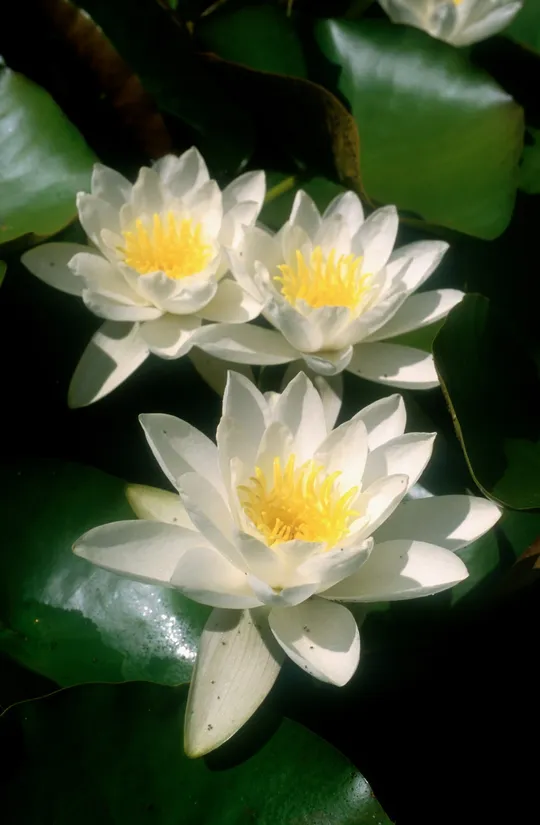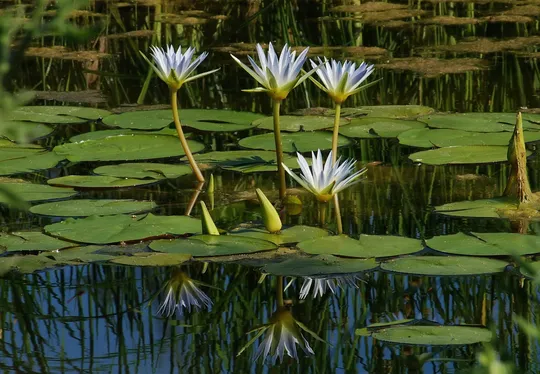White Water-lily, European White Waterlily
Nymphaea alba


The
rhizome of Nymphaea Alba contains tannins and gallic acid and in the
past it was used to produce dyes.
Nymphaea Alba is extinct in Israel, where it once grew, in the Hula
Valley and the Sharon. It was collected in the Hula Valley in the 1950s, when the
Hula was drained, in the Hula marshes and in the Enan Stream area. N. Alba plants from the Hula were cultivated
in the Tel Aviv University Botanical Garden and were reintroduced to the Hula
Nature Reserve in the early 1990s, and subsequently to Agamon HaHula. In 1999,
the Hula Reserve was partially drained and it was re-flooded in 2000. At that
time N. Alba made a spontaneous appearance and hundreds of plants developed.
In the years 2002-2003, these populations died out until all the plants became
extinct (Talia Oron, pers. comm.). In the Sharon, N. Alba was collected in the 1920s in
the Batih Pond near Hadera, in the Ya'ar Pond and in Wadi Poleg, but it has not
been seen since.
Ponds, streams
and standing water.
The genus Nymphaea comprises 40 species common
throughout the world. Many of the species have synonyms as a result of its many
varieties and hybrids and the great diversity of flower color and form. This
has led to confusion in identifying the species. In Israel, another species, N. nouchali also grows (see there). N.
Alba is characteristic of
the temperate zone and Israel is the southern limit of its distribution. N.
nouchali is a tropical
species and Israel is the northern limit of its distribution. N.
Alba is an ancient
species, whose leaves and fruit remains were found in the Pliocene fossil floras,
five million years ago.
·
Before the Hula marshes and the Sharon
marshes were drained, seven sites were known in two regions, but they are all
extinct now, and no plants survived in the wild in Israel.
·
The extinctions were caused by wetland
drainage in the Hula Valley and the Sharon. The populations that were reintroduced
and developed in the Hula Reserve suffered damage from nutrias.
·
Despite the relocation efforts, Nymphaea Alba became extinct. The
reasons for the disappearance of the populations that were restored to the Hula
Nature Reserve are unclear.
·
The status of the plant in North
Africa according to IUCN categories is Vulnerable (VU). However, in the
Mediterranean European countries the species is not threatened and is
classified Least Concern (LC).
Efforts should be
made to re-naturalize Nymphaea Alba in the Hula Reserve and Agamon HaHula
from sources in botanical gardens in Israel and to monitor the reintroduced
populations.
Nymphaea Alba grows in all the
European countries. In the Mediterranean Islands – Corsica, Sardinia and Sicily
it is rare, and it is absent from Crete. It is found in the Maghreb countries –
Morocco, Algeria and Tunisia, but is rare. It grows in Georgia near the Black
Sea. Israel was formerly the southern limit of its distribution.
Nymphaea Alba is an aquatic
plant with erect floating leaves that once grew at a small number of sites in
the Hula and Sharon marshes, but became extinct in the wild. Israel is the
southern distribution limit of the species. N. alba should be reintroduced to the Hula and Sharon marshes.
ויזל, י. וליפשיץ, נ. 1979. צמחי מים בישראל. הוצאת רשות שמורות הטבע
סלע, י. 1982. התחזור הנמפיאה לנופי המים שלנו טבע וארץ כ"ה/1: 28-29.
Current Occupancy Map
| 1000 squre meter pixel | 5000 squre meter pixel | 10000 squre meter pixel | |
|---|---|---|---|
| number of observations | 0 | 0 | 0 |
| in total pixels | 0 | 0 | 0 |
| Family | Nymphaeaceae |
| Classification | On the endangered species list |
| Ecosystem | Mediterranean humid |
| Chorotype | Euro–Siberian - Mediterranean |
| Conservation Site | Hula Reserve, Agamon HaHula |
| Rarity |
1
3
6
|
|---|---|
| Vulnerability |
0
4
4
|
| Attractiveness |
0
4
4
|
| Endemism |
0
0
4
|
| Red number |
1
-1.0
10
|
| Peripherality | N |
| IUCN category | DD EW EX LC CR EN VU NT |
| Threat Definition according to the red book | Extinct |
 Based on:
Based on:






